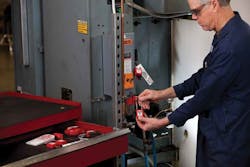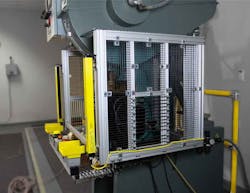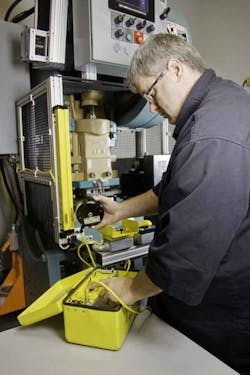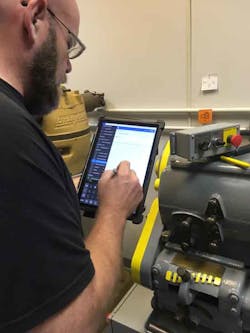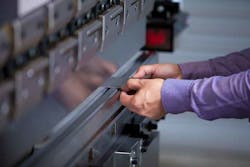Risk Assessment vs. Safeguarding Assessment: Which is Right for Your Machines?
According to the National Safety Council (NSC) Injury Facts report, the U.S. suffers more than 100,000 preventable workplace injuries annually. These injuries are defined as “a cut, fracture, sprain, or amputation that results from a work incident or from a single, instantaneous exposure in the work environment.” In 2016, the NSC estimated that these injuries cost American industry $151.1 billion, including wage and productivity losses, medical expenses, and administrative costs.
When it comes to preventable incidents across industries, manufacturing is the second highest sector despite strict Occupational Safety & Health Administration (OSHA) regulations and American National Standards Institute (ANSI) standards, specifically, OSHA 5(a)(1) General Duty Clause, OSHA 1910.212(a)(1) General Requirements, and ANSI B11 Series Standards for Industrial Machinery.
As reported in OSHA’s Top 10 Most Cited Violations Report, a major cause of these injuries, year after year, is unguarded hazardous machinery with 2,109 citations issued in 2017, resulting in more than $7 million in fines levied against businesses. Some experts estimate that an alarming 50% or more of all industrial machinery in the U.S. does not comply with OSHA’s and ANSI’s minimum guarding safety requirements, resulting in more than 800 deaths per year. OSHA 1910.212(a)(1), the most common section citation, says one or more methods of machine guarding shall be provided to protect the operator and other employees in the machine area, followed by OSHA 1910.212(a)(3)(ii) which says machines with operation that expose an employee to injury shall be guarded.
Workers not properly trained in using Lock-out/Tag-out procedures or ignore that training, not realizing the dangers of not using them. (Courtesy of Masterlock)
In this era of unprecedented manufacturing innovation, complete with advanced automation, the Industrial Internet of Things (IIoT), AI, and robotics, why is something as fundamental as machine safeguarding frequently overlooked? There are many reasons. Some facility safety managers may be lulled into a false sense of security because there have not been any serious injuries in their plants or they are rare in their facility. Some managers might also wrongly assume newly purchased machinery arrives fully compliant with safety rules and regs, not realizing OEM’s are typically concerned with new machinery price competitiveness, not necessarily guarding compliance. Additionally, some managers may wrongly assume older machines (pre-1970s and before OSHA was formed) are “grandfathered in.” Those managers may be surprised to discover grandfathering does not exist; all machines must comply with guarding rules and rules and regs, regardless of their age. Furthermore, some facilities may comply with all safeguarding rules and regs, but their machine operators knowingly or unknowingly bypass safeguards, or in some situations, safeguarding equipment is improperly installed.
For whatever reason the facility has not properly safeguarded its machinery, there is a process for determining compliance: a risk assessment as outlined by ANSI B11.0. Although many organizations and consultants provide assessments, two types of machine assessments reign supreme: the risk assessment and the safeguarding assessment.
Let’s take look at both and see how they can help organizations better protect people operating machines and reduce the risk at the facility. It is important to note that whichever choice facility safety managers make, assessments should be made by independent facilitators or assessment specialists. They are the ones with the extensive code expertise and the necessary electrical, mechanical, and control system knowledge applicable to the equipment. In addition, independent facilitators provide fresh, non-biased eyes to see less-obvious hazards facility safety or operations managers might overlook in simple visual inspections, such as poor lighting, utility line issues, and forklift traffic.
Risk assessments should be conducted annually, and whenever new machinery is installed or a major change to an existing machine or production line has been made. Additionally, in an ideal world, pre- and post-assessments would be done to verify that hazards identified in the assessment were properly mitigated. Unfortunately, as is too often the case, it takes an accident or an OSHA citation to spur management into comprehensive risk identification and mitigation.
When an electrically interlocked shield is lifted, positive contacts on a microswitch open and send a stop signal to the machine.
Risk Assessment
A risk assessment is the first step in any machine safeguarding process, as outlined in ANSI B11 Series Standards for Industrial Machinery, ANSI/RIA R15.06-2012 Safety Standards for Industrial Robots, and the National Fire Protection Association (NFPA) 79-2015 Electrical Standard for Industrial Machinery.
Its overarching goal is to identify hazards associated with machinery or robots. This requires an on-site visit by a risk assessment professional who audits and assigns each machine and robot a Risk Level based on three factors: Severity of Injury, Exposure Frequency, and Avoidance Likelihood. On average, skilled assessment professionals test 5 to10 machines a day, depending on machine type, age, and location. They use software-based tools that make the process quicker and easier than working through a pen-and-paper risk assessment form.
Before the visit and based on project scope, the specialist needs to review a comprehensive machine list and other documentation, including corporate safety standards, lockout/tagout (LOTO) procedures, electrical and mechanical drawings, floorplan layout, and equipment manuals. This information lets the specialist ask questions that often trigger in-depth conversation and discussion.
Operators and everyone passing by are protected from a powerful mechanical press by light curtains and perimeter guarding. The operator has access to palm button/emergency stop (orange button to the left) in case of malfunctions or possible injuries.
Although many machine models share similar designs, companies often adapt them to make specific parts based on customer and market demands. Even when machines are the same model from the same supplier, they can be altered so that there’s a drastic difference in the risk levels. Therefore, the specialists will need to review the machine’s lifecycle report to understand every alteration made it.
Assessing a machine for risk begins with reviewing its operational states with tests to identify potential hazards during start-up, cycle, and stopping. The specialist may perform a Stop-Time Measurement (STM) test to determine the machine’s reaction time after receiving a stop signal to ensure safeguarding devices have proper safety distance. The specialist also establishes if those just passing by or others in the area could be hurt if here’s an incident, in addition to the operator. In many operations it takes two or more operators to get parts through a machine; a risk assessment will be required for these operators as well.
Along with assessing a machine’s production risks, the specialist must analyze tasks performed by machine operators interacting with the machine, loading and unloading materials, planned and unplanned maintenance, tool-changes, and general housekeeping.
During risk assessment, the specialist photographs the machines and generates a final hazard report documenting their findings and risk levels. Hazardous findings of each machine are broken down into classifications:
Critical: There is an imminent life-threatening or dismemberment hazard; immediate action is needed to reduce risk and improve operator safety
Mandatory: There is an imminent hazard of potential injury; action is required to reduce risk, improve operator safety, and comply with OSHA/ANSI standards
Compliant: There is no recognized hazard that creates potential for injury; no action is required.
Risk assessment of robotic machinery is different. Assessing risks with a robot follows RIA TR R15.306-2014. This standard breaks down risks according to potential severity of injury, frequency of exposure to the hazard, and likelihood of avoiding the hazard. Risk levels are broken down as Very High, High, Medium, Low, or Negligible.
For instance, a Very High level is where injury severity is non-reversible—i.e., death or limb amputation—and exposure to this risk occurs at least once per hour. The likelihood of avoiding the risk would be rated by the RAI as “A3 Not Possible,” meaning there is insufficient clearance to move out of the way, the operator is trapped by the robot’s layout, or safeguarding does not offer protection from the hazard as is the case with explosions or eruptions.
Identified risks can be as minor as a light bulb needing replacement or a missing yellow background on an e-Stop, or as extreme as the absence of barrier guards on a 100-ton hydraulic press or an exposed high-speed drive belt that could entangle an employee.
While a risk assessment helps identify problems, it does not provide specific safety solutions nor cost estimates. It takes a machine safeguarding assessment to do that.
Continuity monitoring devices measure electrical continuity between two electrodes to verify they are actually touching the part about to be welded. If anything blocks the movement of the electrode, such as a finger, the welding machine will not operate.
Safeguarding Assessment
Safeguarding assessments are closely related to risk assessments. They take the risk assessments to the next level by addressing machine safeguarding, control compliance, disconnecting isolating power, anti-restart protection, mechanical transmission coverage, and any hazards related to machine operation with suggested methods and costs of correcting the findings. Because safeguarding assessments identify specific solutions and costs, they are, unsurprisingly, the type recommended by most facility safety managers. Like risk assessments, the machine safeguarding assessments are based on ANSI B11 Series Standards for Industrial Machinery, ANSI/RIA R15.06-2012 Safety Standards for Industrial Robots, and NFPA 79-2015. These sources suggest safeguarding devices that will put the facility in compliance and work with the production processes.
During the guarding assessment, a safeguarding specialist visits the site and intensively audits each machine and determines compliance in five areas: safeguards, controls, disconnects, starters, and covers. The specialist may request copies of electrical, pneumatic, or hydraulic schematics, in addition to operator manuals. He can also ask for control panel access so engineers can review control circuits for electrical compatibility of any proposed safeguarding devices and to verify the control circuits’ reliability to determine interfacing requirements of suggested safety devices.
Then the specialist focuses on risk reduction using this basic methodology:
Eliminate access. Good safeguarding devices eliminates the possibility of operators or others placing parts of their bodies near hazardous moving parts.
Reduce exposure. Operators should not be able to remove, bypass, or tamper with machine safeguards. To minimize risk exposure, all guards and devices must be securely mounted at the point-of-operation and durable enough to withstand industrial environments, vandalism, and heavy usage. Automated feeding and ejection mechanisms reduce operator exposure to the point of operation while handling stock. Where that is not possible, hand feeding tools should be used along with appropriate guards and machine safeguarding devices.
Create no new hazards. A safeguard defeats its own purpose if it creates a hazard such as a shear point, a jagged edge, or an unfinished surface with a sharp edge. The edges of guards, for instance, should be rolled or bolted so that they eliminate sharp edges.
Create no interference. Any safeguard which impedes a worker from performing a job quickly and comfortably might soon be overridden or disregarded. Proper safeguarding can actually enhance efficiency because it relieves the workers’ apprehensions about injuries.
Allow safe lubrication. Place oil reservoirs outside the guard and a line leading to the lubrication point to reduce the need for workers to enter a hazardous area.
Administrative controls. Without administrative oversight and supervisory control, machine safeguarding programs fail. Training is key to establishing a safety culture. Operators need to be trained to follow Standard Operating Procedures provided by machine manufacturers to reduce hazards and related risks. Also, machine operators need to be made aware of hazardous energy control, Tagout/Lockout, and other safety procedures required during maintenance or removing a jam. Don’t simply assume operators can run the machine safely because they have related experience. Require ongoing training for all employees.
Production methods, electrical alterations, and controls integrations are usually the main reasons why machine safeguards are customized. Off-the-shelf guards may not provide for all variables, but customized safeguards can account for actual machine design and use. Customized safety devices can meet an organization’s requirements and automated to reduce operator fatigue. In addition, detailed electrical and hydraulic schematics and Bills of Material (BOMs) should be provided to track compliance and ordering replacement parts.
Stop time measurement determines precisely how much time goes by between triggering a machine’s operating control or a safeguarding device and when a dangerous movement comes to a halt.
Unlike risk assessments, safeguarding assessments recognize the problem and solution. A final compliance report and safeguarding project proposal is given to facility management. It identifies deficiencies of each machine that does not comply with current or specified regs and standards. When not in compliance, the proposal offers standard and customized safeguarding fixes, along with associated costs and timelines to install on equipment and help make machines compliant. Each proposed fix is carefully weighed against factors such as risk-reduction benefit, productivity, technological feasibility, economic impact, and maintainability. In this way, safeguarding assessments follows the OSHA/ANSI approach to controlling machine hazards: eliminate the hazard by design, control the hazard by guarding, post warnings, select personal protective equipment, and provide training.
The same basic process applies to robots. Many robotic safeguarding situations require customized, engineered devices that work seamlessly with an organization’s automation cells, facilities, and operations. An engineer reviews the electrical and hydraulic machine schematics which are supplied by the customer. They evaluate existing interfaces or controls for compliance, and identity any need for special interfaces or controls.
All robotic engineered design devices must meet OSHA, ANSI/RIA R15.06-2012 (which mirrors ISO 10218-1,2:2011) and NFPA 79. And given the rapid growth of robotics, new standards are being developed, such as ANSI/RIA R15.08, which should be taken into consideration for any robot or collaborative robot safeguarding project.
Machine and robot safeguarding solutions ensure OSHA/ANSI/RIA/NFPA code compliance, letting operators maintain productivity and reduce risk. In the end, good safeguarding devices should be easier to work with rather than around.
A risk assessment collects data for each machine, identifies compliance issues and prescribes safeguarding solutions to reduce risk at the plant level.
Risk Reduction Strategies
When evaluating ways to reduce risks of identified hazards, consider each machine and its unique risks. There are three basic methods:
- Eliminate or reduce risks to a “tolerable” level by installing a new, inherently safe machine. Please note that what constitutes “tolerable” to one company is not necessary tolerable to another. Defining “tolerable risk” deserves significant reflection within an organization.
- Install the necessary safeguarding equipment on an existing machine to minimize risks which cannot be eliminated. And train operators on the machine’s safe working methods.
- Change the production process to eliminate the hazard. Perhaps the operator performs actions that increase his exposure to serious hazards? Or recent upstream changes have created a more dangerous environment? Even a small change in procedures can make for a safer, more efficient operation.
Next, once safeguarding equipment is installed, it needs to be tested for effectiveness, and document the results. Always review and update work and maintenance procedures, plus train all personnel on the newly installed safety devices and procedures.
As part of testing, it is recommended that a post-safeguarding assessment be performed to verify risk levels have been reduced to a tolerable level. If not, the process should be repeated until they do reach a tolerable level. If, however, the resulting risk level is determined to be negligible, the process is near completion. It may not be practical or cost-effective to totally eliminate risk or enclose the machine so that employees have zero exposure. Zero exposure is not usually attainable or practical, but it is possible to minimize employee risk of injury.
Both machine risk assessments and machine safeguarding assessments are critical first steps in any machine or robot safeguarding project. Both assessments are key to employee safety, paving the way for risk reduction measures that are effective and economical. Machine risk assessments provide a comprehensive hazard analysis with a risk ranking, whereas, machine safeguarding assessments identify safeguarding solutions and provide cost estimates for implementation. Which one is right for an organization depends upon the specific needs of the organization, in addition to the organization’s objectives, desired outputs, and risk levels.
Protective laser-based devices can handle situations such as this box bending, bending with flanges, or where light curtain effectiveness is diminished due to excessive blanking or muting.
The Good Old Days? Not for Machine Operators
When manufacturing moved from small shops to factories during the Industrial Revolution, a horde of inexperienced (and often very young) workers were confronted with a confusing jumble of moving belts, pulleys, and gears. While pre-industrial craftsmen faced risks from kilns and hand tools, industrialization introduced massive steam engines and powerful, fast-moving machines.
In America, the use of labor-saving machines was driven by a regulatory climate that discouraged employers’ interest in safety. As a result, manufacturers developed machinery that was both highly productive and highly dangerous. Overworked American factory workers in the 1900s faced constant risk of losing limbs and severe burns–and if they survived, a short retirement with damaged vision and hearing and a good chance of lung infections.
Injured workers might sue employers for damages but winning anything was rare. Only about half of all workers permanently disabled by factory injuries recovered anything, and they only received an average of a year’s pay. Because employee accidents were so cheap, industrial machinery was developed with little or no reference to safeguarding.
Not unexpectedly, reports from state labor bureaus at the time were full of tragedies. These reports spurred the budding labor movement to call for factory safety. In 1877, Massachusetts passed the nation's first factory inspection law. It required guards on belts, shafts and gears, protection on elevators, and adequate fire exits. By 1890, nine states provided for factory inspectors, 13 required machine safeguarding, and 21 had legislated limited provision for health hazards.
On the national level, congress passed a federal employers' liability law in 1908 that made it more expensive for companies to have a machine accident on their books. Thanks to the new law, worker injuries that once cost companies $200 to resolve now cost almost $2,000. Compensation laws and other liability costs suddenly made workplace injuries an expensive proposition for many employers. Manufacturing companies began to work to create safer production equipment, and managers began getting tasked with identifying hazards on machines.
After WWII, accidents declined as powerful labor unions played an increasingly important role in promoting machine safeguarding. Personnel protective equipment became a requirement with gloves, masks, and aprons given to workers. Posters hung throughout the plant floor reminded workers of their responsibility to think and act safely. Basic guards and safety mats became common around industrial machinery.
The American Standards Association published its Safety Code for Mechanical Power Transmission Apparatus in the 1940s. It was like OSHA 1910.218 (The Occupational Safety and Health Standards on machinery and machine guarding for forging machines) and was written as a guide for machine manufacturers on guarding systems.
The National Safety Council found that the injuries dropped from 15 injuries per 100 full-time workers in 1941 to 9 in 1950. By 1956, it reached a decade low of 6 per 100 workers. As impressive as those numbers were, the on-the-job death toll in the 1950s remained a stubborn 13,000 to 16,000 workers annually.
In the 1960s, economic expansion again led to rising injury rates. Resulting political pressures forced Congress to establish the Occupational Safety and Health Administration (OSHA) in 1970. By the end of that year, President Nixon signed into law the Williams-Steiger Occupational Safety and Health Act. It gave the Federal Government authority to set and enforce safety and health standards for most of the country's workers.
When the agency opened for business in April 1971, OSHA covered 56 million workers at 3.5 million workplaces. Today, 105 million private-sector workers and employers at 6.9 million sites look to OSHA for guidance on workplace safety and health issues.
Safeguarding technology and requirements have come a long way since the Industrial Revolution. Advanced light curtains, interlocked guards, laser-guided systems, and presence sensors are now commonplace.
Despite this progress, the lack of machine guarding has been named to OSHA’S Top 10 Most Cited Violations List virtually every year since the list began. In 2017 OSHA handed out nearly 2,000 violations to companies for failing to have machines and equipment adequately guarded, underscoring how much work there is left to do.
Matt Brenner is vice president of sales for Rockford Systems.

